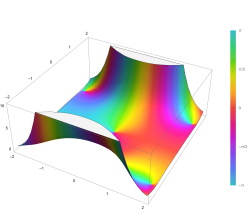Dawson function
In mathematics, the Dawson function or Dawson integral[1] (named after H. G. Dawson[2]) is the one-sided Fourier–Laplace sine transform of the Gaussian function.
Definition
The Dawson function is defined as either: [math]\displaystyle{ D_+(x) = e^{-x^2} \int_0^x e^{t^2}\,dt, }[/math] also denoted as [math]\displaystyle{ F(x) }[/math] or [math]\displaystyle{ D(x), }[/math] or alternatively
[math]\displaystyle{ D_-(x) = e^{x^2} \int_0^x e^{-t^2}\,dt.\! }[/math]
The Dawson function is the one-sided Fourier–Laplace sine transform of the Gaussian function, [math]\displaystyle{ D_+(x) = \frac12 \int_0^\infty e^{-t^2/4}\,\sin(xt)\,dt. }[/math]
It is closely related to the error function erf, as
- [math]\displaystyle{ D_+(x) = {\sqrt{\pi} \over 2} e^{-x^2} \operatorname{erfi} (x) = - {i \sqrt{\pi} \over 2 }e^{-x^2} \operatorname{erf} (ix) }[/math]
where erfi is the imaginary error function, erfi(x) = −i erf(ix). Similarly,
[math]\displaystyle{ D_-(x) = \frac{\sqrt{\pi}}{2} e^{x^2} \operatorname{erf}(x) }[/math] in terms of the real error function, erf.
In terms of either erfi or the Faddeeva function [math]\displaystyle{ w(z), }[/math] the Dawson function can be extended to the entire complex plane:[3] [math]\displaystyle{ F(z) = {\sqrt{\pi} \over 2} e^{-z^2} \operatorname{erfi} (z) = \frac{i\sqrt{\pi}}{2} \left[ e^{-z^2} - w(z) \right], }[/math] which simplifies to [math]\displaystyle{ D_+(x) = F(x) = \frac{\sqrt{\pi}}{2} \operatorname{Im}[w(x)] }[/math] [math]\displaystyle{ D_-(x) = i F(-ix) = -\frac{\sqrt{\pi}}{2} \left[ e^{x^2} - w(-ix) \right] }[/math] for real [math]\displaystyle{ x. }[/math]
For [math]\displaystyle{ |x| }[/math] near zero, F(x) ≈ x. For [math]\displaystyle{ |x| }[/math] large, F(x) ≈ 1/(2x). More specifically, near the origin it has the series expansion [math]\displaystyle{ F(x) = \sum_{k=0}^\infty \frac{(-1)^k \, 2^k}{(2k+1)!!} \, x^{2k+1} = x - \frac{2}{3} x^3 + \frac{4}{15} x^5 - \cdots, }[/math] while for large [math]\displaystyle{ x }[/math] it has the asymptotic expansion [math]\displaystyle{ F(x) = \frac{1}{2 x} + \frac{1}{4 x^3} + \frac{3}{8 x^5} + \cdots. }[/math]
More precisely [math]\displaystyle{ \left|F(x) - \sum_{k=0}^{N} \frac{(2k-1)!!}{2^{k+1} x^{2k+1}}\right| \leq \frac{C_N}{x^{2N+3}}. }[/math] where [math]\displaystyle{ n!! }[/math] is the double factorial.
[math]\displaystyle{ F(x) }[/math] satisfies the differential equation [math]\displaystyle{ \frac{dF}{dx} + 2xF = 1\,\! }[/math] with the initial condition [math]\displaystyle{ F(0) = 0. }[/math] Consequently, it has extrema for [math]\displaystyle{ F(x) = \frac{1}{2 x}, }[/math] resulting in x = ±0.92413887... (OEIS: A133841), F(x) = ±0.54104422... (OEIS: A133842).
Inflection points follow for [math]\displaystyle{ F(x) = \frac{x}{2 x^2 - 1}, }[/math] resulting in x = ±1.50197526... (OEIS: A133843), F(x) = ±0.42768661... (OEIS: A245262). (Apart from the trivial inflection point at [math]\displaystyle{ x = 0, }[/math] [math]\displaystyle{ F(x) = 0. }[/math])
Relation to Hilbert transform of Gaussian
The Hilbert transform of the Gaussian is defined as [math]\displaystyle{ H(y) = \pi^{-1} \operatorname{P.V.} \int_{-\infty}^\infty \frac{e^{-x^2}}{y-x} \, dx }[/math]
P.V. denotes the Cauchy principal value, and we restrict ourselves to real [math]\displaystyle{ y. }[/math] [math]\displaystyle{ H(y) }[/math] can be related to the Dawson function as follows. Inside a principal value integral, we can treat [math]\displaystyle{ 1/u }[/math] as a generalized function or distribution, and use the Fourier representation [math]\displaystyle{ {1 \over u} = \int_0^\infty dk \, \sin ku = \int_0^\infty dk \, \operatorname{Im} e^{iku}. }[/math]
With [math]\displaystyle{ 1/u = 1/(y-x), }[/math] we use the exponential representation of [math]\displaystyle{ \sin(ku) }[/math] and complete the square with respect to [math]\displaystyle{ x }[/math] to find [math]\displaystyle{ \pi H(y) = \operatorname{Im} \int_0^\infty dk \,\exp[-k^2/4+iky] \int_{-\infty}^\infty dx \, \exp[-(x+ik/2)^2]. }[/math]
We can shift the integral over [math]\displaystyle{ x }[/math] to the real axis, and it gives [math]\displaystyle{ \pi^{1/2}. }[/math] Thus [math]\displaystyle{ \pi^{1/2} H(y) = \operatorname{Im} \int_0^\infty dk \, \exp[-k^2/4+iky]. }[/math]
We complete the square with respect to [math]\displaystyle{ k }[/math] and obtain [math]\displaystyle{ \pi^{1/2}H(y) = e^{-y^2} \operatorname{Im} \int_0^\infty dk \, \exp[-(k/2-iy)^2]. }[/math]
We change variables to [math]\displaystyle{ u = ik/2+y: }[/math] [math]\displaystyle{ \pi^{1/2}H(y) = -2e^{-y^2} \operatorname{Im} i \int_y^{i\infty+y} du\ e^{u^2}. }[/math]
The integral can be performed as a contour integral around a rectangle in the complex plane. Taking the imaginary part of the result gives [math]\displaystyle{ H(y) = 2\pi^{-1/2} F(y) }[/math] where [math]\displaystyle{ F(y) }[/math] is the Dawson function as defined above.
The Hilbert transform of [math]\displaystyle{ x^{2n}e^{-x^2} }[/math] is also related to the Dawson function. We see this with the technique of differentiating inside the integral sign. Let [math]\displaystyle{ H_n = \pi^{-1} \operatorname{P.V.} \int_{-\infty}^\infty \frac{x^{2n}e^{-x^2}}{y-x} \, dx. }[/math]
Introduce [math]\displaystyle{ H_a = \pi^{-1} \operatorname{P.V.} \int_{-\infty}^\infty {e^{-ax^2} \over y-x} \, dx. }[/math]
The [math]\displaystyle{ n }[/math]th derivative is [math]\displaystyle{ {\partial^nH_a \over \partial a^n} = (-1)^n\pi^{-1} \operatorname{P.V.} \int_{-\infty}^\infty \frac{x^{2n}e^{-ax^2}}{y-x} \, dx. }[/math]
We thus find [math]\displaystyle{ \left . H_n = (-1)^n \frac{\partial^nH_a}{\partial a^n} \right|_{a=1}. }[/math]
The derivatives are performed first, then the result evaluated at [math]\displaystyle{ a = 1. }[/math] A change of variable also gives [math]\displaystyle{ H_a = 2\pi^{-1/2}F(y\sqrt a). }[/math] Since [math]\displaystyle{ F'(y) = 1-2yF(y), }[/math] we can write [math]\displaystyle{ H_n = P_1(y)+P_2(y)F(y) }[/math] where [math]\displaystyle{ P_1 }[/math] and [math]\displaystyle{ P_2 }[/math] are polynomials. For example, [math]\displaystyle{ H_1 = -\pi^{-1/2}y + 2\pi^{-1/2}y^2F(y). }[/math] Alternatively, [math]\displaystyle{ H_n }[/math] can be calculated using the recurrence relation (for [math]\displaystyle{ n \geq 0 }[/math]) [math]\displaystyle{ H_{n+1}(y) = y^2 H_n(y) - \frac{(2n-1)!!}{\sqrt{\pi} 2^n} y. }[/math]
See also
References
- ↑ Temme, N. M. (2010), "Error Functions, Dawson's and Fresnel Integrals", in Olver, Frank W. J.; Lozier, Daniel M.; Boisvert, Ronald F. et al., NIST Handbook of Mathematical Functions, Cambridge University Press, ISBN 978-0-521-19225-5, http://dlmf.nist.gov/7
- ↑ Dawson, H. G. (1897). "On the Numerical Value of [math]\displaystyle{ \textstyle\int_0^h \exp(x^2) \, dx }[/math]". Proceedings of the London Mathematical Society s1-29 (1): 519–522. doi:10.1112/plms/s1-29.1.519. https://zenodo.org/record/1433401.
- ↑ Mofreh R. Zaghloul and Ahmed N. Ali, "Algorithm 916: Computing the Faddeyeva and Voigt Functions," ACM Trans. Math. Soft. 38 (2), 15 (2011). Preprint available at arXiv:1106.0151.
External links
- gsl_sf_dawson in the GNU Scientific Library
- libcerf, numeric C library for complex error functions, provides a function voigt(x, sigma, gamma) with approximately 13–14 digits precision. It is based on the Faddeeva function as implemented in the MIT Faddeeva Package
- Dawson's Integral (at Mathworld)
- Error functions
 |




